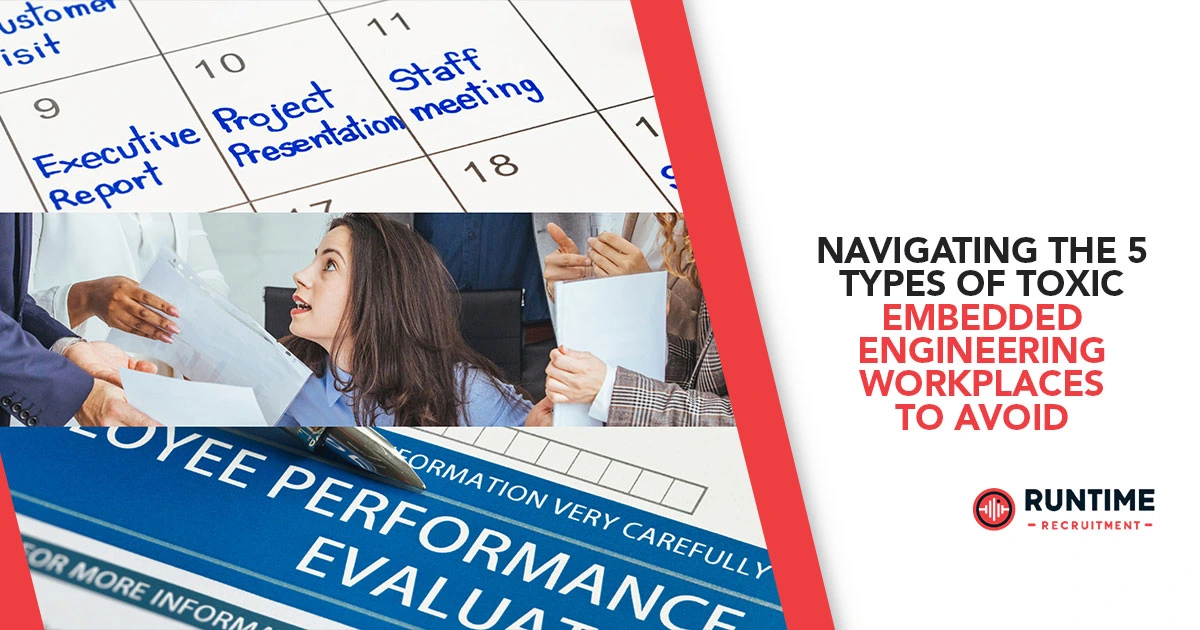It’s 2025, and the landscape of embedded engineering continues to evolve at a blistering pace. From IoT devices to advanced robotics, the demand for skilled embedded engineers is higher than ever. Yet, amidst this booming industry, a silent, corrosive force can undermine even the most promising careers: toxic workplaces. For embedded engineers, whose work demands precision, problem-solving, and often long hours, a healthy work environment isn’t a luxury – it’s a necessity.
This in-depth article aims to equip embedded engineers with the knowledge to identify and, more importantly, avoid the five most prevalent types of toxic workplaces. Recognizing these insidious environments early can save you from burnout, stagnation, and a significant hit to your professional well-being.
The Foundation of Embedded Engineering: Why Culture Matters
Before we dive into the specifics, let’s briefly touch upon why workplace culture is so critically important for embedded engineers. Our discipline is unique. It’s a blend of hardware and software, often involving intricate low-level programming, real-time constraints, and meticulous debugging.
- Complex Problem Solving: Embedded systems are inherently complex. Solving intractable bugs or optimizing for performance requires deep focus and collaborative effort. A toxic environment stifles this.
- Long Development Cycles: Unlike some software disciplines, embedded projects often have longer development cycles. Sustained motivation and engagement are crucial.
- High Stakes: From medical devices to automotive systems, embedded failures can have serious, even life-threatening, consequences. This inherent pressure needs a supportive, not punitive, environment.
- Continuous Learning: The embedded world is constantly innovating. A healthy workplace fosters continuous learning and skill development, essential for staying relevant.
When these elements are compromised by a toxic culture, the impact isn’t just on individual well-being; it’s on project quality, team morale, and ultimately, the success of the entire organization.
The 5 Types of Toxic Embedded Engineering Workplaces to Avoid
Let’s dissect the five primary categories of toxic environments that embedded engineers should be wary of. While some overlap may exist, each type presents a distinct set of challenges.
1. The “Hero Culture” Hothouse: Burnout as a Badge of Honor
Characteristics:
- Glorified Overtime: Engineers are implicitly (or explicitly) expected to work excessive hours. Staying late, working weekends, and sacrificing personal life are seen as dedication and are often rewarded, even if the work could have been managed more efficiently.
- Crisis-Driven Development: Projects are perpetually in “crunch mode.” This isn’t occasional; it’s the default. Poor planning, unrealistic deadlines, and a lack of proper resource allocation lead to constant fire-fighting.
- Individualistic Focus: Success is attributed to individual “heroes” who single-handedly solve critical issues, rather than acknowledging team collaboration or robust processes. This often leads to knowledge silos and a reluctance to share information.
- Fear of Failure: Mistakes are met with severe criticism or blame, rather than being viewed as learning opportunities. This discourages experimentation and innovation.
- Lack of Documentation/Process: “Just get it done” supersedes proper documentation, testing protocols, and robust design processes. The “hero” fixes the problem in the moment, but the underlying issues persist.
Why it’s Toxic for Embedded Engineers:
Embedded engineering demands meticulous attention to detail and careful planning. The “hero culture” undermines this by promoting rushed work and discouraging systematic approaches. Debugging complex hardware-software interactions is incredibly taxing, and doing so under constant duress leads to critical errors and burnout. Furthermore, the lack of documentation ensures that tribal knowledge replaces institutional knowledge, making onboarding new engineers a nightmare and perpetuating the cycle of “heroics.” Engineers in such environments often suffer from chronic stress, anxiety, and ultimately, a complete loss of passion for their craft. They become “fixers” rather than innovators.
Red Flags During Interview/Observation:
- Casual mentions of “working hard” or “pulling all-nighters” being common.
- Interviewers bragging about how little sleep they get.
- A palpable sense of urgency or stress in the office, even during non-critical periods.
- Lack of clear project timelines or a constantly shifting scope.
- Emphasis on individual achievements over team collaboration.
2. The “Ivory Tower” Management: Disconnected Leadership & Micro-Management
Characteristics:
- Top-Down Dictates: Decisions are made by management with little to no input from the engineers who will implement them. Technical feasibility, real-world constraints, and practical challenges are often ignored.
- Lack of Technical Understanding: Managers lack a fundamental understanding of embedded systems, leading to unrealistic expectations, poor technical direction, and an inability to properly support their teams.
- Micro-Management: Despite their lack of understanding, managers dictate minute details of implementation, undermining engineers’ expertise and autonomy. Every line of code, every hardware choice, must be approved.
- Blame-Shifting: When projects inevitably fail due to poor planning or unrealistic expectations, the blame is pushed down to the engineering team.
- Absence of Growth Opportunities: Since engineers are not trusted with autonomy, there are limited opportunities for skill development, leadership, or taking ownership of significant architectural decisions.
Why it’s Toxic for Embedded Engineers:
Embedded engineering thrives on autonomy, problem-solving, and a deep understanding of the technical stack. “Ivory Tower” management stifles innovation and critical thinking. Engineers become cogs in a machine, disengaged and demotivated. The constant micro-management is demoralizing and prevents engineers from applying their specialized knowledge effectively. Imagine trying to design a complex PCB or optimize a real-time OS kernel when every decision is second-guessed by someone who doesn’t grasp the fundamentals. This environment breeds resentment, frustration, and a pervasive feeling of being undervalued.
Red Flags During Interview/Observation:
- Managers speaking entirely in business jargon without technical depth.
- Interviewers struggling to answer questions about the development process or technical challenges.
- A sense of engineers being “told what to do” rather than contributing ideas.
- Questions about highly specific, low-level tasks without discussing the broader system architecture.
- Evidence of high turnover rates, particularly among senior engineers.
3. The “Stagnant Swamp”: Lack of Innovation & Professional Development
Characteristics:
- Outdated Technology: The company is resistant to adopting new tools, languages, frameworks, or hardware platforms, clinging to archaic technologies “because that’s how we’ve always done it.”
- No Training or Upskilling: There’s no budget or initiative for professional development, conferences, certifications, or even internal knowledge-sharing sessions.
- Repetitive, Unchallenging Work: Engineers are stuck working on the same legacy systems or performing highly repetitive tasks without opportunities for new projects or increased responsibility.
- Fear of Change: Any proposal for improvement, innovation, or process optimization is met with resistance, bureaucracy, or outright dismissal.
- Lack of Vision: There’s no clear long-term technical roadmap or a sense of direction for future products/technologies.
Why it’s Toxic for Embedded Engineers:
Embedded engineering is a field of constant evolution. New microcontrollers, communication protocols, RTOSes, and development methodologies emerge regularly. A “stagnant swamp” environment is a career killer. Engineers become technically obsolete, their skills atrophy, and their market value diminishes. The lack of intellectual stimulation leads to boredom and professional dissatisfaction. For ambitious embedded engineers who are passionate about learning and pushing boundaries, this environment is soul-crushing. It’s not just about job satisfaction; it’s about career longevity.
Red Flags During Interview/Observation:
- Interviewers only discussing technologies that are decades old without mention of newer ones.
- Lack of a clear answer about professional development opportunities or training budgets.
- Evidence of a long-standing product without significant updates or new feature development.
- Engineers appearing disengaged or resigned to their current state.
- A company culture that boasts about “stability” but seems to confuse it with “stagnation.”
4. The “Political Minefield”: Backstabbing, Silos, and Lack of Transparency
Characteristics:
- Inter-Departmental Blame Games: Different teams (e.g., hardware, software, QA) are constantly at odds, blaming each other for issues rather than collaborating to find solutions.
- Information Hoarding/Silos: Critical information is not shared freely. Teams or individuals deliberately withhold knowledge to maintain power or control.
- Favoritism and Nepotism: Promotions, raises, and desirable projects are awarded based on personal connections or office politics rather than merit or performance.
- Lack of Transparency: Decision-making processes are opaque. Employees are kept in the dark about company performance, strategic shifts, or even changes that directly impact their work.
- High Turnover (Silent Exodus): Employees leave quietly, citing “personal reasons,” but the underlying issue is the toxic political climate.
Why it’s Toxic for Embedded Engineers:
Embedded development is inherently cross-functional. Success hinges on seamless collaboration between hardware design, firmware development, software integration, and testing. A “political minefield” destroys this synergy. Engineers spend more time navigating internal conflicts and defending themselves than actually building products. Information silos prevent effective debugging and integrated problem-solving. Imagine a hardware engineer needing crucial firmware details, but the firmware team refuses to share until the last minute. This environment creates immense frustration, delays, and often leads to technically inferior products. The constant stress of political maneuvering saps energy and creative drive.
Red Flags During Interview/Observation:
- Interviewers making thinly veiled negative comments about other departments or individuals.
- A sense of defensiveness or a lack of direct answers when asking about collaboration.
- Unclear organizational charts or reporting structures.
- Rumors or whispers about internal conflicts or “who is in favor.”
- Questions about how you handle conflict without discussing resolution processes.
5. The “Toxic Leadership” Lair: Abusive Behavior & Disrespect
Characteristics:
- Abusive or Demeaning Communication: Managers or senior engineers regularly use condescending tones, public shaming, yelling, or personal attacks.
- Lack of Respect for Work-Life Balance: Pressure to work constantly, disregard for personal appointments, and an expectation of being “always on call.”
- Unethical Practices: Pressure to cut corners, misrepresent data, or engage in practices that compromise product quality or ethical standards.
- No Recognition or Appreciation: Hard work and accomplishments are ignored or downplayed, leading to a feeling of being invisible and undervalued.
- High Control, Low Trust: Employees are treated as untrustworthy and are subjected to excessive monitoring or suspicion, rather than being empowered.
Why it’s Toxic for Embedded Engineers:
This is arguably the most damaging type of toxic workplace. Direct abuse and disrespect erode an individual’s self-worth, mental health, and professional confidence. Embedded engineers often pour their heart and soul into their work; to have that effort met with contempt or abuse is devastating. This environment leads to severe stress, anxiety, depression, and ultimately forces talented individuals out of the profession entirely. Beyond the personal toll, it also damages product quality, as engineers working under duress are more prone to errors and less likely to report issues for fear of reprisal.
Red Flags During Interview/Observation:
- Witnessing or hearing about managers or senior staff speaking disrespectfully to subordinates.
- A palpable sense of fear or tension when managers are present.
- Glassdoor reviews or similar platforms citing consistent patterns of abusive leadership.
- Interviewers making offhand comments about “thick skin” being required.
- Lack of clear HR processes or an unresponsive HR department.
Escaping the Toxicity: Your Action Plan
Identifying these toxic environments is the first crucial step. The next is to take action.
- During the Job Search:
- Do Your Homework: Research companies on Glassdoor, LinkedIn, and other review sites. Pay attention to recurring themes in negative reviews.
- Ask Targeted Questions: During interviews, don’t just answer questions; ask insightful ones. Inquire about:
- “How are technical disagreements resolved?”
- “Describe a typical week for an engineer here, including average work hours.”
- “What professional development opportunities are available?”
- “How does this team collaborate with other departments?”
- “Can you give an example of how feedback is given and received?”
- Trust Your Gut: Pay attention to the overall “vibe” during interviews and office tours. Do people seem happy? Engaged? Or stressed and reserved?
- Network: Talk to current and former employees if possible. Their insights can be invaluable.
- If You’re Already There:
- Document Everything: Keep a record of incidents, especially those related to abusive behavior, unrealistic demands, or lack of support.
- Seek Internal Solutions (with Caution): If safe and appropriate, try to address issues with your direct manager or HR. Be prepared for potential pushback.
- Prioritize Your Well-being: Your mental and physical health come first. Don’t sacrifice them for a toxic job.
- Start Your Exit Strategy: Begin quietly looking for new opportunities. Update your resume, network, and prepare for interviews. The best time to look for a job is when you have one.
- Don’t Burn Bridges (if possible): Even when leaving a toxic environment, maintain professionalism. You never know when paths might cross again.
Conclusion: Your Career, Your Health
The demand for embedded engineers is robust, offering incredible opportunities to innovate and build the future. However, this high demand can sometimes mask the underlying issues within certain workplaces. Being an embedded engineer requires sharp intellect, perseverance, and a collaborative spirit. These qualities flourish in environments of respect, support, and continuous learning.
By understanding the five types of toxic embedded engineering workplaces – the Hero Culture, Ivory Tower Management, Stagnant Swamp, Political Minefield, and Toxic Leadership Lair – you empower yourself to make informed career decisions. Your skills are valuable, and you deserve a workplace where you can thrive, grow, and truly enjoy the impactful work you do. Don’t settle for anything less. Your career and your well-being depend on it.
Further Reading:
- “9 Signs You’re in a Toxic Work Environment—and What to Do About It” by The Muse
- “How to Protect Your Team From a Toxic Work Culture” by Harvard Business Review
- “Burnout Is About Your Workplace, Not Your People” by Jennifer Moss
- “The Manager’s Path: A Guide for Tech Leaders Navigating Growth and Change” by Charity Majors, Camille Fournier, and Jessica Kerr









